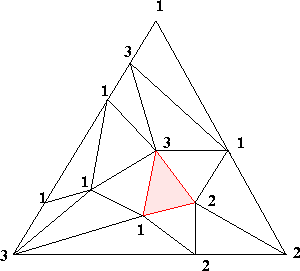
PROBLEM OF THE MONTH
NOVEMBER 2001

Show that among the small triangles there is always one whose vertices are numbered by 1, 2 and 3.
There are several possible solutions of this problem. Here is one possible approach:
We show that the number of small triangles whose vertices are labeled with
![]() is odd and thus actually
is odd and thus actually ![]() !
!
We enumerate all small triangles in the picture as ![]() ,
,
![]() and denote by
and denote by ![]() the number of edges with endpoints
the number of edges with endpoints ![]() and
and ![]() in each triangle
in each triangle ![]() . Thus, if say
the vertices of
. Thus, if say
the vertices of ![]() are labeled by
are labeled by ![]() , then
, then ![]() , and so on ...
, and so on ...
Observe now that obviously we have
Let
According to the hypothesis of the problem, edges labeled ![]() or
or ![]() can occur only on
the
can occur only on
the ![]() -edge of the large triangle
-edge of the large triangle ![]() . We start walking along the edge
. We start walking along the edge ![]() of the triangle
of the triangle
![]() starting at the vertex
starting at the vertex ![]() toward the vertex
toward the vertex ![]() . Now, only when we first pass an edge labeled
. Now, only when we first pass an edge labeled ![]() will we arrive at the first vertex labeled
will we arrive at the first vertex labeled ![]() . A number of vertices labeled
. A number of vertices labeled ![]() may now follow, and
only after we have passed a segment
may now follow, and
only after we have passed a segment ![]() do we reach a label
do we reach a label ![]() , and so on. Thus after an odd number of
segments
, and so on. Thus after an odd number of
segments ![]() or
or ![]() we arrive at vertices labeled
we arrive at vertices labeled ![]() , and after an even number of such
segments we arrive at vertices labeled
, and after an even number of such
segments we arrive at vertices labeled ![]() . Since the last vertex we will reach is the vertex
. Since the last vertex we will reach is the vertex ![]() of the
big triangle
of the
big triangle ![]() , it follows that the total number of segments
, it follows that the total number of segments ![]() or
or ![]() lying on the
side
lying on the
side ![]() of the big triangle
of the big triangle ![]() must be odd! The same reasoning applies for each of the other
edges of the big triangle
must be odd! The same reasoning applies for each of the other
edges of the big triangle ![]() , so we deduce that
, so we deduce that ![]() , the total number of
, the total number of ![]() -edges lying on the boundary of
-edges lying on the boundary of ![]() ,
must be odd. This finishes the proof of our claim.
,
must be odd. This finishes the proof of our claim.